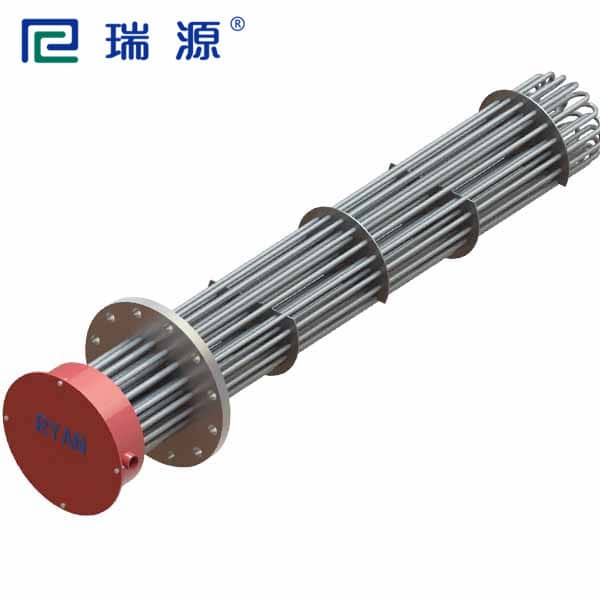Heating tubes are the core of electric thermal oil heatershttps://8ruiyan.com/en/all-organic-heat-carrier-boilers/. They convert electricity into heat to warm the oil. Their condition directly impacts system efficiency and safety.

How Do Heating Tubes Work?
- Electricity → Heat: Current flows through internal resistance wires (e.g., nickel-chromium alloy).
- Transferencia de calor: Wires heat up, warming the surrounding insulating magnesium oxide (MgO) powder.
- Heating the Oil: Heat transfers to the metal sheath (stainless steel), then to flowing thermal oil.
Key Design: Surface load (power per unit area) is critical. Too high → oil cracking/coking; too low → wasted energy.
Why Are They Vital?
- Core Heat Source: No tubes = no heating.
- Efficiency Drivers: >95% energy conversion.
- Safety Guardians: Prevent localized overheating.
- System Lifespan: Stable operation protects oil quality.
Common Problems & Causes
- Severe Coking
- Symptoms: Thick black carbon on tubes.
- Causes: High oil temp, low flow, aged/poor-quality oil.
- Result: Poor heat transfer, energy waste, tube burnout.
- Burnout (Open Circuit)
- Symptoms: No heating; infinite resistance.
- Causes: Poor heat dissipation (e.g., coking), dry firing, high voltage.
- Result: Reduced heating power.
- Short Circuit
- Symptoms: Tripped breakers; near-zero insulation resistance.
- Causes: Damp MgO powder, voids, cracked sheath, seal failure.
- Risk: EXTREMELY hazardous! Electric shock/fire risk.
- Corrosion/Leaks
- Symptoms: Rust, pitting, oil leaks.
- Causes: Corrosive contaminants, wrong material (e.g., 304 instead of 316L stainless steel).
- Risk: Oil loss, pollution, fire hazard.
- Performance Decline
- Symptoms: Slow heating; abnormal resistance rise.
- Causes: Aged resistance wires, loose connections, degraded MgO.
- Result: Higher energy costs.
Other triggers: Voltage fluctuations, improper installation, cold-start errors.
Maintenance & Replacement Guide
1. Daily Monitoring
- Check current/voltage stability.
- Track oil temperature rise rate.
- Verify instrument accuracy.
- Test oil quality yearly (acidity, carbon residue, viscosity).
2. Routine Checks (Every 3–6 months)
- Visual Inspection:
- Examine tubes for coking, deformation, cracks, corrosion.
- Clean loose residue with a soft brush. Never scrape hard carbon!
- Electrical Tests:
- Resistance: Match initial values (±5%).
- Insulation: ≥50 MΩ (cold); ≥1 MΩ (hot). <1 MΩ? REPLACE IMMEDIATELY!
- Clean oil circuits regularly.
3. When to Replace
- Open/short circuits.
- Insulation resistance <1 MΩ.
- Deformation, bulging, cracks, leaks.
- Severe corrosion or coking.
4. Safe Replacement Steps
- DISCONNECT power! Lock out & tag switches.
- Depressurize & cool oil to <40°C.
- Drain oil from the chamber.
- Disconnect wires (label them!). Remove old tube.
- Clean the chamber and flange.
- Install new tube:
- Confirm exact specs (voltage/power/size/material).
- Test resistance/insulation before installing.
- Use new high-temp seals. Tighten bolts evenly.
- Reconnect wires correctly.
- Refill oil, purge air.
- Test-run at low temps, monitoring current/temperature.
⚠️ SAFETY FIRST!
- Only trained technicians should perform work.
- Wear PPE: heat-resistant gloves, goggles, coveralls.
- Follow protocols strictly—hot oil leaks cause severe burns/fires!
Conclusión
Heating tubes are the thermal oil heater’s “powerhouse.” Understand their role. Spot problems early. Maintain proactively. Replace correctly. This ensures safe, efficient operations. Remember: Preventative maintenance costs far less than breakdowns!
For further consultation, please contact our technical team for expert advice.
Whatsapp:86-19106101570
wechat:86-19106101570
email:nieyili@cnryan.com
